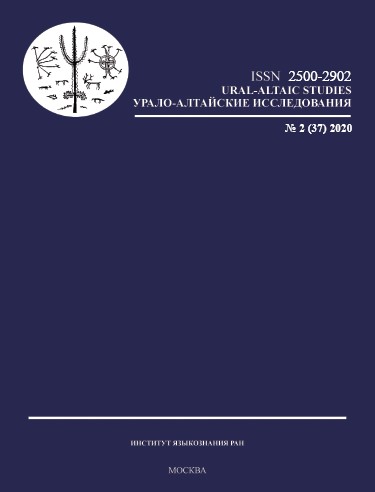Полисемия в списках самодийской базисной лексики и языковые контакты
Polysemy in the Samoyed core lexicon lists and language contacts
Author(s): Idaliya V. FedotovaSubject(s): Theoretical Linguistics, Lexis, Semantics, Comparative Linguistics, Philology, Turkic languages
Published by: Институт языкознания Российской академии наук
Keywords: core lexicon lists; the Samoyed languages; the Turkic languages; the Tungusic languages; polysemy; syncretism; semantic generality; semantic shift; etymology; semantic reconstruction;
Summary/Abstract: This paper investigates cases of semantic shifts and proto-language polysemy in the Samoyed core lexicon. This research focuses on the shifts which have analogies in Turkic and Tungusic languages, identified with the help of semantic reconstruction. Special maps were created at LingvoDoc linguistic platform in order to demonstrate areas of similar polysemy and semantic shifts, possibly contact-induced. Using materials from archival and expeditionary dictionaries, the paper proposes a detailed account of the available lexicon of the Samoyed languages within the scope of core lexicon. Our results show 15 semantic shifts in the form of polysemy, semantic evolution and cognates: ‘sun, day’; ‘earth (place), soil’; ‘earth’ > ‘ashes’; ‘earth’ > ‘sand’; ‘earth’ > ‘clay’; ‘sand, pebbles’; ‘human skin, animal skin’; ‘skin’ > ‘bark’; ‘hair, fleece, feather’; ‘feather, wing’; ‘person, man’; ‘meat, body’; ‘neck, throat’; ‘good’ > ‘beautiful’; ‘soft’ > ‘warm’. The maps created at LingvoDoc provide evidence of intense language contacts in the past and present, or display an absence of such evidence. Judging by the shape and the size of the areas on the maps it can be seen that some cases of polysemy are local, while others are widespread on the territory of Western Siberia, whole Siberia or whole Eurasia. The highlight is that 7 Samoyed-Turkic-Tungusic parallels, 5 Samoyed-Turkic parallels and 3 Samoyed-Tungusic parallels have been found within the 100-item Swadesh wordlists of these languages. Also, some cases were identified in which extralinguistic factors might have influenced similar changes in genealogically non-related languages (‘bark’ in Samoyed, Turkic and Tungusic) and suggested a Turkic influence on the Samoyed inherited lexicon (‘ashes’, ‘clay’).
Journal: Урало-алтайские исследования
- Issue Year: 2020
- Issue No: 02 (37)
- Page Range: 77-113
- Page Count: 37
- Language: Russian

